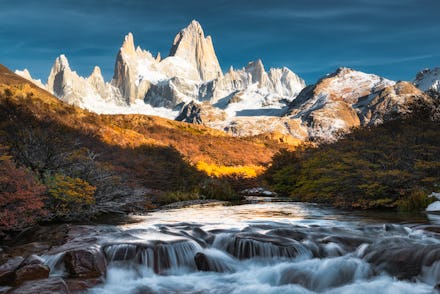Researchers think they've figured out why mountains are so damn tall

Geoscientists have debated for years what determines the height of a mountain. A 2005 article from Scientific American pointed to tectonic activity, climate, and erosion as factors that create the shape and maximum height of a mountain. Tectonic activity, the authors of the article theorized, created mountains as the Earth's plates collided, climate shaped erosion rates, and erosion created the steepness of a mountain. This was the old theory — now, researchers with the GFZ German Research Centre for Geoscience and the University of Münster have published a study in Nature that suggests climate and erosion don't play as large a part as people thought. Rather, the forces and tension behind the moving tectonic plates are the primary drivers.
Tectonic plates make up the Earth's crust like giant pieces of an enormous puzzle. The borders of each plate usually lines up fairly smoothly and fit snugly against each other. But it's theorized that activity from the mantle, the area between the Earth's surface (called the 'crust') and the core of the planet, can cause tectonic plates to move, resulting in earthquakes and volcanic activity.
Earth scientists believe that, in the prehistoric era, mountain ranges were also created by the movement of these tectonic plates. When the plates collided into each other, part of the land crumpled upward, similar to how the hood of a car does when it crashes head-on with another car. This is how mountains and mountain ranges are created; if you look at a map that shows the boundaries of tectonic plates, you'll often find mountain ranges and a history of earthquakes in areas along the lines.
But instead of the plates crashing and erosion wearing down the mountain to a certain height, the research team's new findings indicate that the stress and immense forces behind the collision are what truly create the height. The head of the team, Dr. Armin Dielforder, led the group to analyze plate boundaries and create calculations that can determine how the stress, energy, and tension — referred to as forces or shear forces — behind plate movement can create mountains of different heights. Dr. Dielforder's team gathered research data that recorded measurable friction and strength in the subsurface of mountain ranges all over the world. They used calculations to estimate how high the mountain range should be based on the measurement of these forces, and then compared it to existing data on current mountain heights.
The calculations matched the actual mountain heights, which led the research team to conclude that tectonic activity determined the height of mountain ranges without much influence from climate and erosion. This also indicates that any mountains that have changed in height are likely due to a change in forces, not a change in climate or environment. Additionally, these findings show that mountains can maintain their height against hazards like rapid erosion so long as the forces behind their creation are still active.
The research team believes their discovery could usher in more opportunities to study mountain growth more accurately. For the average person, results like these can be a fascinating find that makes it sound like these mountains are alive and growing. It's no wonder there are so many myths about mountains and volcanoes.